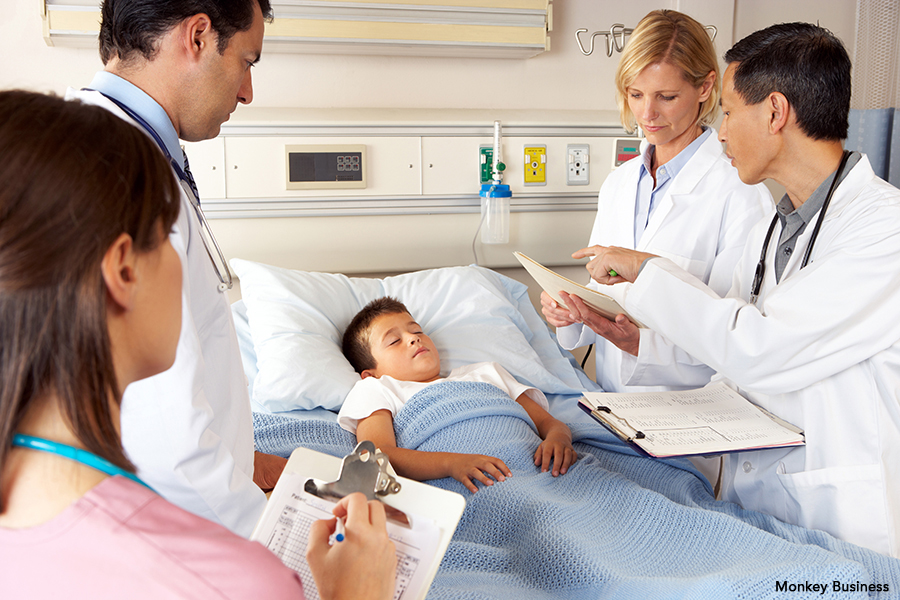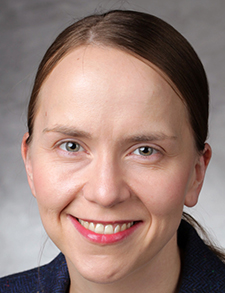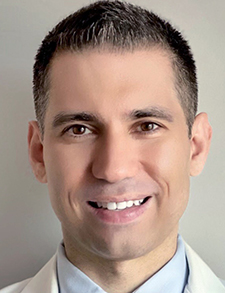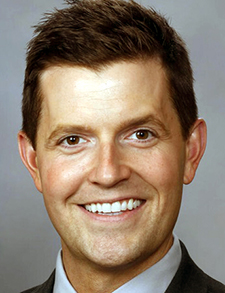
Bedside rounding, a practice dating back more than a century, is not uniformly implemented. Many physicians are unsure of its effectiveness in improving patient care and teaching learners, and it conflicts with many pandemic protocols.
Some hospitalists suggest selecting patients or scenarios for bedside rounding instead of meeting in a conference room or catching colleagues in the hallway. Others believe it should be used for all patients.
The pros
Many clinicians see advantages to bedside rounding; for one, patients seem to like it.

Dr. Massart
“When done well, everyone benefits,” said Annie Massart, MD, assistant professor of medicine at Emory University in Atlanta. “The literature suggests that patients prefer it, which makes sense because it’s an important tool for centering our patients in their care.” Dr. Massart, who says she’s passionate about bedside rounds, describes the opportunity to foster shared decision-making as one major pro for bedside rounding.

Dr. Landrigan
In pediatrics, involving patients—or, more accurately, their parents—in decision making is the norm, says Christopher Landrigan, MD, MPH, chief, division of general pediatrics at Boston Children’s Hospital in Boston and the William Berenberg Professor of Pediatrics at Harvard Medical School. This helps to keep them informed and involved with their child’s care. Still, Dr. Landrigan thinks bedside rounding can translate into adult medicine well and that the biggest barrier is the hospital culture.
Another advantage to bedside rounding is that it can help trainees grow as more experienced physicians can observe them and provide granular feedback, Dr. Massart said. “Learners want to improve and are tired of being told to ‘read more’ at the end of each rotation. When I’ve spent each morning with them at the bedside, I’m able to observe their exam skills and give them nuanced feedback on how they connect with their patients.”

Dr. Farkhondehpour
Specifically bedside rounds can help assess trainees on empathy, how they answer patient questions, how they relay a plan with minimal medical jargon, and how they navigate language and cultural barriers, says Ali Farkhondehpour, MD, FACP, FHM, associate clinical professor with the University of California San Diego, and a hospitalist in the division of hospital medicine at U.C. San Diego Medical Center.

Dr. Ratelle
Bedside rounding also can be just as, or more, efficient compared to other methods. A Journal of Hospital Medicine article found that when comparing bedside rounds to walking rounds, the time spent on them per patient tends to be similar.1 However, it may not feel that way, says John T. Ratelle, MD, associate professor of medicine and a hospitalist with the Mayo Clinic in Rochester, Minn. “There’s some upfront investment required. It’s a learned skill. It’s hard to go into a room and talk to a patient about their condition with them as well as to attendings and professional staff,” he said. He describes bedside rounding as cognitively more demanding, which is likely what makes it feel longer.
They may be in the minority, but bedside rounding is also what just seems to work best for some hospitalists. Dr. Ratelle worked previously with an intern who was trained early on in bedside rounding and actually preferred it to other methods.
The cons
Of course, if bedside rounds were perfect, everyone would use them. Yet they have some drawbacks.
As Dr. Ratelle mentions, the cognitive demands of bedside rounding compared with simply meeting with peers outside of the patient’s room could make the latter approach preferable. The current demands on medical professionals in hospitals combined with the idea of doing bedside rounds may sound overwhelming. “It’d be cognitively less demanding to meet in a conference room that’s a ‘safe space’,” he said. “I think that’s one reason why bedside rounding is withering.”
Another reason that bedside rounding may be used less frequently is that many hospitals are still in “COVID-19 mode,” even if the threat of the virus is less foreboding than it once was. The routine of discussing care outside of the patient’s room continues at many medical centers, Dr. Farkhondehpour says. Some are pushing to return to pre-COVID-19 bedside routines while others are sticking with the methods they have used over the past few years. “I think this has become an ‘old habits are hard to break’ scenario,” he said.
Bedside rounds may not be the right choice for every patient scenario, Dr. Farkhondehpour says. For instance, complex goals-of-care discussions are often lengthy, especially when hospice may be part of it. “The mornings are hard to initiate a meaningful goals-of-care discussion and then leave and come back to pick up where you left off from,” he said.
Hybrid method
While some hospitalists may have a strong proclivity for bedside rounding or card flipping in internal medicine, Dr. Ratelle says the right answer may be somewhere in between, deciding which scenarios would benefit the most from bedside rounds.
First, you need to be with a patient who needs it and benefits from it, he says.
Next, you need a leader who feels comfortable at the bedside. “Often that’s the attending physician, but it doesn’t have to be,” Dr. Ratelle said. Leadership support from the hospital system is also crucial.
The third factor is having the time and space to do a bedside round. If the workload for a particular day seems manageable, that also sets the day up for bedside rounding. However, Dr. Landrigan points out, research finds the time it takes is about the same as conference-room rounds.
Dr. Farkhondehpour favors a hybrid model of bedside rounding for new patients admitted overnight or patients with new acute overnight events, a table round or card flip on patients who tend to be stable with less acute medical issues, and a walk-around on all others.
Dr. Landrigan prefers using bedside rounds for all patients, even if that creates a mental frameshift and additional education and coaching. “Because bedside rounds have been shown to broadly improve care, there is a risk that if you pick and choose whom you’re going to do them on, systemic bias might creep in. Better to do them for everyone, and do them well,” he said.
8 Tips for Better Bedside Rounding
There are a few guiding principles to keep in mind if you want to push for more bedside rounding at your medical center.
1. Get the right people on board. This includes hospital leadership as well as at least one influential hospitalist who will support and use bedside rounding, Dr. Landrigan says. If they are on board, others will follow.
2. Set expectations on the first day of training. Dr. Farkhondehpour advises explaining the benefits of bedside rounds to the team, including confirmation of patient history, teaching physical exam techniques, the assessment of communication skills, and the benefit of having these discussions with patients and the family to reduce returns to the bedside. For those new to bedside rounds, it can be helpful to start with some cases that are not medically complex, to set them up for success.
3. Prepare participants with some basic health-literacy concepts. With I-PASS, a methodology for patient-centered decision-making and patient handoff that has been developed and researched by Dr. Landrigan, one key component is training medical staff to use simpler health terms when possible. So, instead of saying, “The patient was febrile and hypertensive,” you could say, “The patient had a fever and high blood pressure.” Getting out of “medical speak” will make the information you share easier for patients to follow during bedside rounds.
4. Consider which conversations are best for bedside rounds and which are better for afternoon discussions with patients. If you need a complex goals-of-care discussion or have to deliver bad news to a patient (like a cancer diagnosis), that may be better served during times other than morning bedside rounds, Dr. Farkhondehpour says. An afternoon visit may be a less rushed time to discuss the next steps and the prognosis, he says.
5. Use the teach-back method with patients. After devising a treatment plan during a bedside round, Dr. Landrigan recommends saying to the patient or their parents or caregivers, “I know we’ve gone through a lot of information, but can you tell me what you understand the plan to be?” He says this helps confirm what they understood. “In medicine, we often just hope that they’ll grasp it, which isn’t often the case,” he said.
6. If you’re the physician training another physician, make it clear to patients who their doctor is. Dr. Massart likes to introduce herself as “the supervising physician, working with your doctor, Dr. Smith,” to highlight the physician learner as their doctor. “When the trainee presents at the bedside and I ask them about the plan for the day, patients get to see the intern or student owning their plan of care,” she said. This is in contrast with team rounds in the conference room, where patients inevitably see Dr. Massart as their doctor if she’s the one doing updates after rounds.
7. Involve technology when possible. “Whether it’s a computer on wheels or an iPad, having a computer on rounds is very helpful for reviewing data and real-time order entry,” Dr. Massart said. She mentions a study done that asked interns at Emory about facilitators and barriers for bedside rounds; it found that readily accessible workstations on wheels were part of the “secret sauce” to an optimal rounding experience.2
If or when available, technology that patients can use—be it a tablet where they can easily see information such as the medications they are using, or a portal they can access—also could be part of the experience.
8. Be flexible. Every patient, learner, and situation is different. By staying flexible with trainees and patients, you can better meet their needs, Dr. Ratelle says. Thoughtful planning for when and how to use bedside rounds can help avoid situations like the one Dr. Massart had as a resident when an attending had the whole team do bedside rounds from 9 a.m. to 3 p.m. without a lunch break
Vanessa Caceres is a medical writer in Bradenton, Fla.
References
- Ricotta DN, et al. Things we do for no reason: Card flipping rounds. J Hosp Med. 2020;15:498-501.
- Spicer JO, et al. Optimizing the educational value of bedside rounds by exploring perceptions of internal medicine residents. South Med J. 2022;115:294-300.
Additional Reading from The Journal of Hospital Medicine
Long ago before the computers invaded us, it was a pleasure to do rounds with the patients, but now is time consuming to fill all the metrics. Discard patients before 10 am, transition plan of care, finish the notes before discharges, etc…How to put your team PT, OT, Speech, pharmacy, RT, RNs, care management team, social worker, students, and you together, and every one finish…without stress or burn out…
Very informative article and pertinent to the times. After more than 35 years as a “private practice” solo, internist, I personally find daily bedside rounds informative, necessary, and demanded by patients. May be apt to quote here:To study the phenomenon of disease without books is to sail an uncharted sea, while to study books without patients is not to go to sea at all. –Sir William Osler, “Books and Men” in Boston Medical and Surgical Journal, 1901. So, I feel seeing patients and then reviewing records or reviewing records contemporaneously while seeing patients ( with a mobile app or computer on wheels or many a times a computer that is already there in patient’s room) quite the thing to do.
There is NO SUBSTITUTE for bedside rounding and the opportunity it affords for communication with patients, families and staff. As a teaching tool it is unsurpassed: COVID or no COVID surge. Recommended reading “The Plague” by Albert Camus.
bedsides round is “managing patients” not “teaching”. working with resident is to coach them how to present and use the right terminology. one resident says, “patient denies or refuses etc..” which did not fit well with the patient when using the word “denies” and “refuses”.
with proper guidance and coaching, it could be fun and interested. some patients like it especially when they noticed the enthusiasm..
I have always done bedside rounds with medical students and residents because that is how I was taught. I find it efficient as we put in orders and plans in the computers and laptops as we round. The students learn at the bedside by watching, the attending is forced to polish up on bedside skills and patients are the better for it. I can’t wait for the AI transcriptionist I hear that is becoming available to transcribe and transform speech into intelligent medical records so everyone has a scribe too!